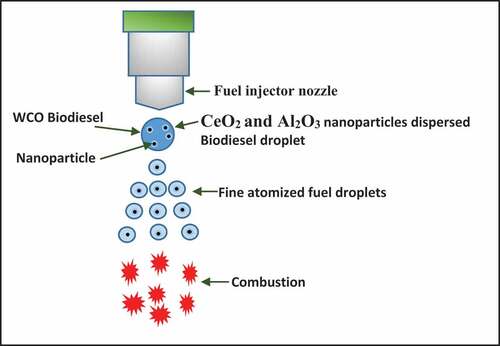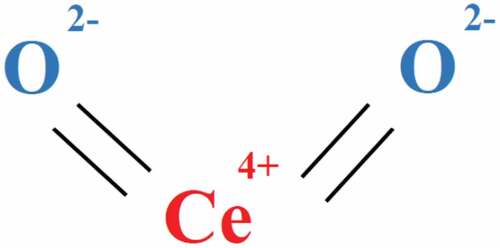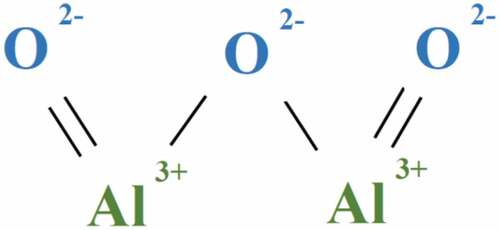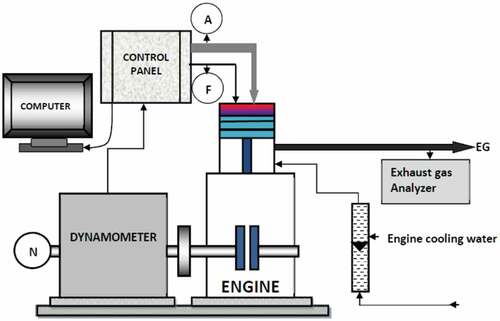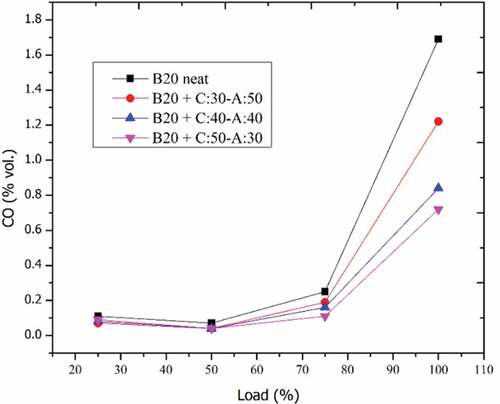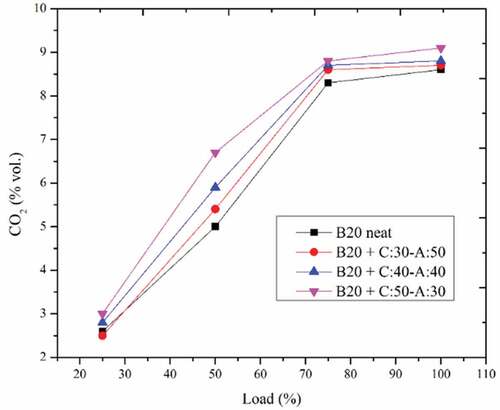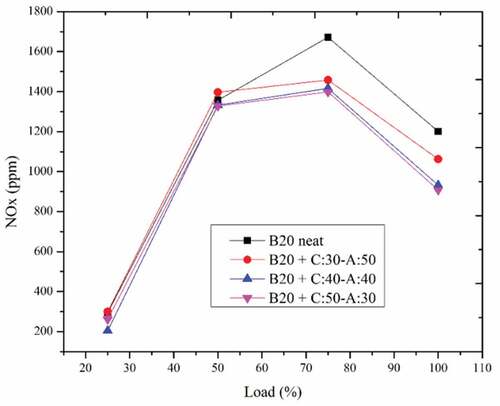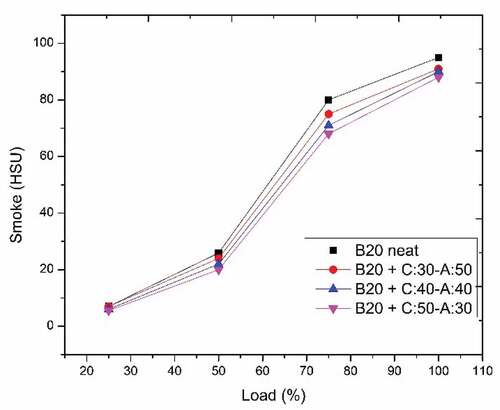 ?Mathematical formulae have been encoded as MathML and are displayed in this HTML version using MathJax in order to improve their display. Uncheck the box to turn MathJax off. This feature requires Javascript. Click on a formula to zoom.
?Mathematical formulae have been encoded as MathML and are displayed in this HTML version using MathJax in order to improve their display. Uncheck the box to turn MathJax off. This feature requires Javascript. Click on a formula to zoom.Abstract
Biofuels are one of the most sought-after renewable energy sources to overcome the current energy crisis in the world. Diesel blended with esters derived from oils has shown appreciable results for its use in compression ignition engines. In this work, B20 (20% biodiesel + 80% diesel by volume) fuel blend comprising 80% diesel and 20% biofuel extracted from waste cooking oil is used as a fuel. Two different metallic oxide nanoparticles (NPs), namely, cerium oxide (CeO2) and aluminium oxide (Al2O3) each having size of 30 nm, are dispersed in B20 biodiesel blend and used to investigate their combined influence on engine combustion. Experiments are conducted to study the engine exhaust emissions of a single cylinder four-stroke diesel engine running at constant speed of 1,500 rpm with varying engine loads. Experiments are carried out with B20 fuel and adding mixtures of CeO2 and Al2O3 nanoparticles in 50–30, 40–40 and 30–50 ppm, respectively, to B20 biodiesel blend. Responses recorded are the emissions of CO, HC, CO2, NOx and smoke. The results reveal that, on adding the nanoparticles, the engine observed a smooth combustion with reduction in the exhaust emissions compared to neat B20 biodiesel operation. B20 blend with 50 ppm of CeO2 and 30 ppm of Al2O3 nanoparticles showed lower exhaust emissions compared to other fuel blends. For the best fuel blend, CO, HC, NOx and smoke are reduced by 57.3%, 22.3%, 24.3% and 7.36%, respectively, compared to neat B20 operation.
PUBLIC INTEREST STATEMENT
In the present study combined influence of Al2O3 and CeO2 nanoparticle in B20 biodiesel has been investigated on the emission characteristics of biodiesel fueled diesel engine run with blends of waste cooking oil ester. Nanoparticles combinations of CeO2 and Al2O3 nanoparticles in 50-30, 40-40 and 30-50 ppm respectively used. NOx, CO HC and CO2 emissions are measured for the nanoparticle blended fuel and are compared with the base line data of neat WCO operation. B20 blend with 50 ppm of CeO2 and 30 ppm of Al2O3 nanoparticles showed lower exhaust emissions. It is concluded that optimum combination of Al2O3 and CeO2 nanoparticles are useful for reduction in the exhaust emission from the diesel engines.
1. Introduction
Energy crisis and environmental pollution are the major issues resulting from industrialization and transportation sectors. In the transport sector, the major contribution of toxic pollutants to the environment is by diesel engine vehicles. Due to higher fuel economy and thermal performance, diesel engines are generally used in transport vehicles as public transport and goods carrier vehicles. Use of fossil-derived fuels in diesel engines increases the environmental pollution due to toxic exhaust gases such as carbon monoxide (CO), unburnt hydrocarbon (HC), oxides of nitrogen (NOx) and smoke. Also, the increased use of these fuels results in in an energy crisis. Several studies have been reported by the researchers, which demonstrate the use of mineral diesel fuels in compression ignition engines and their ill effects to the environment (Geng et al., Citation2017). These issues can be effectively solved by using sustainable energy resources in engines. Sustainable energy resources are renewable and environment-friendly fuels. Biofuels are such kind of fuels which directly and indirectly help to minimize the environmental degradation. Use of biofuels in diesel engines is the most prominent method by which renewable sources such as plant or animal-based oils are used to produce biodiesel. Though the biodiesel is eco-friendly and renewable in nature, its higher viscosity and lower calorific value limit the direct use in diesel engines. Biodiesel has higher viscosity, which causes poor penetration, atomization and mixing of fuel droplets, resulting in incomplete combustion. Lesser calorific value and higher viscosity of biodiesel fuel result in increased specific energy consumption, which in turn causes lower brake thermal efficiency.(Cheikh et al., Citation2016)
Several studies have been conducted all over the world (Kumar et al., Citation2019; Safieddin Ardebili et al., Citation2021, Citation2020; Uyumaz et al., Citation2020) and reported the influence of blending of biodiesel with mineral diesel on engine combustion and emissions. Some studies reported that the viscosity and volatility of biodiesel can be improved by adding oxygenated additives.(Ayhan et al., Citation2020) Use of these methods improves the thermal efficiency. The major disadvantage of biodiesel is its higher NOx emission. This may be due to the inbuilt oxygen content, which may take part in oxidation of nitrogen. Several methods are available and used to minimize NOx emissions of which exhaust gas recirculation (EGR), water emulsion and water injection are the simplest and most economical methods. The use of these methods in engines minimizes NOx emission and also deteriorates the engine efficiency with increase of other emissions.(Zhang et al., Citation2019)
1.1. Use of metallic nanoparticles (NPs) in biodiesel engine
Use of metallic NPs as a fuel additive is another novel method to reduce engine exhaust emissions without changing the engine performance. Thermal and chemical properties of NPs improve the combustion process in engines. Nano-sized particles in suspension form distribute the fuel droplets evenly throughout the combustion chamber. shows the atomization of NPs dispersed in biodiesel droplets in the combustion chamber. Superior thermal conductivity of NPs increases the heat transfer rate between these dispersed fuel droplets and also promotes rapid auto-ignition of the fuel droplets. Some of the NPs also act as a catalyst in fuel combustion and enhance the combustion rate by minimizing the unburnt reactants in the exhaust gas. There are several studies which revealed the use of different types of metallic oxide NPs as an additive to fuel blend.(Kumar, Dinesha, Bran et al., Citation2019; Sajeevan & Sajith, Citation2013; Yaşar et al., Citation2019). Kumar et al. (Kumar, Dinesha, Bran et al., Citation2017) reported the use of 1% by volume of ferrofluid in B20 biodiesel resulted in maximum efficiency with reduced emissions.
1.2. Use of cerium oxide nanoparticles
Ceria is naturally available in +3 and +4 valance state. It is also known as cerium oxide or cerium dioxide with the general chemical formula CeO2. Though it is available in two valance states, +4 valence state has a strong oxidizing tendency due to its non-trivalent nature. The structure of CeO2 NPs is shown in , and the general physicochemical properties are given in .
Table 1. Physicochemical properties of CeO2
When CeO2 is heated to high temperature, it liberates oxygen due to the ionic transformation from +4 to +3 valance state as shown in EquationEq. (1)(1)
(1) .(Mehrizi et al., Citation2018) Ionic transformation reaction is a low-energy reaction, and this encourages the use of cerium oxide as a combustion catalyst.
In biodiesel and HC combustion, CeO2 plays a major role to achieve complete combustion by reducing HC and soot particles. The following chemical equations demonstrate these phenomena.
Another important advantage of CeO2 is the reduction of NOx concentration. Ce2O3 formed during the combustion of fuel reacts with NOx and results in CeO2 and nitrogen as shown EquationEq. (4)(4)
(4) .
Superior thermal conductivity of CeO2 improves the heat transfer tendency. When the nano-sized NPs dispersed in the fuel blend, promote the heat transfer rate between the fuel droplets. This reduces the delay period of the injected fuel and helps to undergo normal combustion without knocking.(Kumar et al., Citation2020)
The applications of CeO2 NPs in biodiesel combustion have been studied by various researchers worldwide. Use of CeO2 NPs reduces the engine emissions such as CO, HC, smoke and NOx emissions by a series of catalytic oxidation and reduction reactions with improved engine efficiency.(Sajeevan & Sajith, Citation2013; Xin et al., Citation2013) Kumar et al. (Kumar et al., Citation2020) reported that the use of CeO2 NPs in B30 and B40 biodiesel blend improved performance with reduced emissions. Venkatesan et al. (Venkatesan et al., Citation2019) conducted experiments and tested the performance and emissions of a biodiesel fuelled engine. They used lemongrass biodiesel with 30 ppm CeO2 NPs as additive. The test results showed 17.2% increase in BTE and a noticeable decrease in CO, HC and NOx emissions. Kumar et al. (M.V. Kumar et al., Citation2019) reported better engine performance and reduced emissions for B20 biodiesel blend with 150 ppm CeO2 NPs combinations. Kapoor et al.(Kapoor et al., Citation2020) observed higher BTE and lower emissions for 100 ppm CeO2 NPs-doped neem oil and diethyl ether blend. The summary of literature related to CeO2 NPs-doped fuel combustion is given in . The use of CeO2 NPs-doped fuel combustion improves the engine efficiency with minimum exhaust emissions.
Table 2. Summary of literature related to CeO2 NPs-doped fuel combustion
1.3. Use of alumina (Al2O3) nanoparticles
Alumina is a general name of aluminium oxide, which is a chemical compound having aluminium and oxygen. It is available naturally as α-Al2O3, which is in crystalline polymorphic phase. The chemical structure of Al2O3 is shown in , and the physicochemical properties are given in . Alumina has a very high thermal conductivity of 30 W m−1k−1 and non-conductor of electricity. Al2O3 in nanoparticle form is commonly used in heat exchangers to enhance heat transfer. It is also used as a fuel additive to improve the combustion. Due to its higher thermal conductivity, it enhances the rate of heat transfer between the fuel droplets. Several literature have been reported on the use of Al2O3 NPs as the fuel additives in biodiesel fuel engine. (Hosseini et al., Citation2017; Prabu et al., Citation2019; Roy et al., Citation2020; Soudagar et al., Citation2020)
Table 3. Physicochemical properties of Al2O3
Researchers have tried using the nano-sized particles of Al2O3 and analysed the engine combustion behaviour. Prabu et al. (Prabu et al., Citation2019) investigated the influence of Al2O3 NPs on the performance and emissions of a diesel engine operated with aloe vera biodiesel blend. They observed minimum engine emissions with 3% reduction in brake thermal efficiency when compared to diesel. Soudagar et al. (Soudagar et al., Citation2020) conducted experiments in a diesel engine using honge methyl ester B20 blend with 20, 40 and 60 ppm of Al2O3 NPs. The results showed improved performance with reduced emissions of HC, CO and smoke for 40 ppm NPs-doped fuel blend. They reported increased NOx emissions for all combinations of NPs-doped fuel blends.
The major literature reported reveal that the use of Al2O3 NPs-doped biodiesel blends increases NOx emissions. Roy et al. (Roy et al., Citation2020) reported higher NOx emission for all combinations of biodiesel blends with 100 ppm NPs. Similarly, Hosseini et al. (Hosseini et al., Citation2017) observed increased NOx for 30, 60 and 90 ppm NPs with B5 and B20 WCO biodiesel blends. The use of Al2O3 NPs increases the combustion temperature which favours the condition for the NOx formation. Catalytic action of Al2O3 helps to minimize CO, HC and smoke emissions. But in most of the cases, it acts negatively on the control of NOx emission. A summary of the literature based on Al2O3 NP combustion is given in .
Table 4. Summary of literature related to Al2O3 NPs-doped fuel combustion
1.4. Motivation to the present study
From the thorough literature survey, it can be observed that the researchers have reported improved performance and reduced emissions for CeO2 NPs-doped biodiesel combustion. CeO2 acts as a catalyst in combustion and not only promotes complete combustion but also helps in the reduction of all toxic pollutants including NOx. The major disadvantage of this NP is that it is rare-earth material and costs high. This limits the use of CeO2 NPs in engine applications.
From , it is clear that the use of Al2O3 NPs improves performance with reduced emission except NOx. Al2O3 NPs enhances the combustions by atomization, dispersion and effective heat transfer between the fuel droplets. But there is no catalytic activity to reduce emissions. There is no positive impact of this NPs on NOx reduction. Though the Al2O3 NPs are cheaper, they produce more NOx compared to neat fuel combustion without NPs. This limits the use of Al2O3 NPs in engine applications. The disadvantages of CeO2 and Al2O3 NPs can be improved by mixing these NPs in different volume fractions. But studies related to the combined effect of two types of metallic NPs with biodiesel blends on the combustion and emission characteristics of a diesel engine are scanty. Hence an effort has been made in the present study to investigate the combined effect of CeO2 and Al2O3 NPs with B20 waste cooking oil biodiesel on the engine exhaust emission of a diesel engine. Literature (Kumar et al., Citation2019) shows that by using 80 ppm of cerium oxide nanoparticles with biodiesel would reduce the emissions to maximum extent. In addition to cerium oxide NPs, Al2O3 NPs also added at different volume proportions to meet 80 ppm concentration to investigate the combined influence on engine emissions.
2. Materials and methods
2.1. Fuel blend preparation
Edible vegetable oil is widely used in frying and cooking purposes. Due to their repeated use may convert them into polycyclic aromatic HCs, dioxins, etc., which are toxic in nature and may cause severe health issues in human beings if consumed. Hence, value-added use of WCO includes soaps, lubricants and as a domestic fuel. The calorific value of WCO is at par with that of other vegetable oil-derived fuels. Properties of WCO biodiesel are comparatively similar to mineral diesel. Hence, it can be used as an alternative diesel engine fuel. The WCO biodiesel is procured from the local biofuel development centre. The WCO biodiesel is blended with diesel in a volume proportion of 20% biodiesel and 80% diesel. From the literature, it is revealed that B20 blend exhibits improved performance with lower emissions compared to other biodiesel blends.(Kumar, Dinesha, Bran et al., Citation2017) The physicochemical properties of the fuel blend have been determined as per ASTM standards and given in .
Table 5. Physicochemical properties of the fuel blend
2.2. Experimental setup and experimentation
A set of experiments are conducted using a four-stroke single-cylinder diesel engine and are shown in . Loading is applied by using eddy current dynamometer. Fuel consumption rate is measured using burette, and the time taken for the consumption of fuel is noted. Air is supplied to the engine inlet through orifice meter. Engine speed is maintained constant at 1,500 rpm, and the speed sensor is used to record the engine speed. First, the engine is run at no load condition for about 20 min and then loaded for 25%, 50%, 75% and 100% of full load condition. Experimental readings are recorded after 5 min of engine operation at the particular load condition. The engine exhaust emissions such as CO, HC, CO2and NOx are recorded by using AVL five gas analyser. AVL smoke meter is used to measure the smoke opacity. Engine exhaust emission parameters such as CO, HC, CO2, NOx and smoke are noted and analysed for all test fuel variants, and the results are compared with baseline B20 operation. Two types of NPs, namely, CeO2 and Al2O3 having 30 nm size, are selected and mixed with B20 biodiesel blend at different volume concentrations. Three types of fuel blends are prepared by combining these NPs at 40–40, 30–50 and 50–30 ppm of CeO2 and Al2O3, respectively. The NPs are properly dispersed using 2% of Triton-X surfactant. These three fuel blends are prepared separately and used for the experimentation.
3. Results and discussion
A number of tests are performed in a diesel engine, and the exhaust emission characteristics are analysed at different load conditions. The engine exhaust emission parameters such as CO, HC, CO2 and NOx are analysed and discussed. The results are compared with neat B20 operation.
3.1. CO emission
illustrates the variation of CO emission for various fuels at different loads. CO emission is minimum at part load conditions and reaches maximum value at full load condition. At full load, a large amount of fuel is injected into the combustion chamber, and a rich fuel–air mixture is formed. Lack of oxygen is available during the combustion, which causes CO formation instead of CO2. Neat B20 biodiesel has higher viscosity, which causes poor atomization and dispersion of the injected fuel droplets. When NPs are added to the fuel blend, it improves the atomization and distribution of fuel due to increased heat transfer characteristics. (Akram et al., Citation2019; Kumar et al., Citation2020; Venkatesan et al., Citation2019) Compared to CeO2, Al2O3 has higher thermal conductivity, which helps as a heat carrier between the fuel droplets. CeO2 has more influence on combustion of fuel by reducing carbon activation temperature. The combined effect of these two types of metallic oxide NPs improves the combustion process and reduced CO emission is obtained. Among these NPs with added fuel variants, B20 with 30 ppm Al2O3 and 50 ppm CeO2 produce minimum CO emissions.
3.2. HC emission
The variation of unburnt HC emission at different loads is depicted in . HC emission also follows a similar trend of CO emission, that is, at part load conditions is lower HC emission and increases as the load is increased. This may be due to several reasons, such as poor atomization, distribution of fuel droplets, incomplete combustion due to lack of oxygen or wall quenching. Due to these reasons, neat B20 has higher HC emissions compared to other fuels. When NPs are added, the problems associated with HC emissions are solved and lower HC emission is obtained. The catalytic action of CeO2 NPs and heat transfer characteristics of Al2O3 NPs improves the combustion, so lower HC emission is obtained.(Kumar et al., Citation2020) Higher volume concentration of Al2O3 has no remarkable benefits on HC emissions.(Soudagar et al., Citation2020) The fuel blend B20 with 30 ppm Al2O3 and 50 ppm CeO2 produces minimum HC emissions compared to other test fuel combinations.
3.3. Carbon dioxide (CO2) emission
Emission of carbon dioxide is the indication of combustion nature of the fuel injected. The higher the CO2 emission, the more complete combustion. Atomization, dispersion, mixing of fuel droplets and availability of oxygen decide the combustion of the injected fuel. B20 shows higher CO2 emission, which may be due to its poor dispersion and uneven mixing of large-sized fuel droplets. shows the CO2 emission characteristics of various fuels at different loads. When nanoparticles are added to B20 blend, they improve the fuel mixing and undergo uniform distribution throughout the combustion chamber. This reduced the tendency of CO formation.(Kana & Shaija, Citation2019; M.V. Kumar et al., Citation2019; Ramesh et al., Citation2018) The presence of Al2O3 improves the atomization and distribution of fuel droplets and increases the heat transfer between them. The presence of CeO2 NPs improves the combustion of carbon by catalytic oxidation process. CeO2 NPs reduce the carbon activation temperature and help the fuel droplets to undergo combustion at lower temperature.(Kumar et al., Citation2020) This results in increased formation of CO2. Higher volume concentration of Al2O3 has no significant effect on CO2 emissions. The fuel blend B20 with 30 ppm Al2O3 and 50 ppm CeO2 NPs produces maximum CO2 emissions compared to other test fuel combinations.
3.4. NOx emission
demonstrates the variation of NOx emission. The formation of NOx is due to many reasons, the important ones being (1) combustion temperature, (2) oxygen content and (3) residual time. If these factors are controlled, the performance of the engine will be effected. The most effective way to reduce NOx is by adding metallic nanoparticles to the fuel blend. The simultaneous oxidation and reduction reactions of CeO2 result in reduced NOx emissions.(Sajeevan & Sajith, Citation2013) This also improves the engine performance by releasing heat from HC and CO oxidation reaction. The presence of CeO2 in the fuel blend plays a major role in reducing NOx emissions.(Hawi et al., Citation2019) In this study, neat B20 has higher NOx emission compared to other fuel variants. When the CeO2 nanoparticle volume fraction is increased from 30 to 50 ppm, the remarkable reduction in NOx emission is achieved.
3.5. Smoke emission
Smoke characteristics for the tested fuel variants are shown in . It is seen that, at lower load conditions, soot formation will be lower and increases rapidly near the full load conditions. Out of the different blends tested, for B20 blend with 50 ppm of CeO2 and 30 ppm of Al2O3 nanoparticles, smoke emission will be minimum and is 7.36% less than neat B20 operation. The catalytic action of CeO2 NPs, together with the better heat transfer characteristics shown by Al2O3 NPs, efficient combustion takes place. This is responsible for lower smoke emissions.
4. Conclusions
In this study, effect of Al2O3 and CeO2 nanoparticles on the engine exhaust emissions using B20 biodiesel blend was investigated. From the experimental studies, the following conclusions can be drawn.
A maximum reduction in engine exhaust emissions was obtained for B20 blend with 30 ppm Al2O3 and 50 ppm CeO2 nanoparticles. The use of 30 ppm Al2O3 and 50 ppm CeO2 simultaneously influences the combustion and reduces CO, HC and smoke emissions. The oxidation and reduction reaction due to catalytic action CeO2 reduces NOx emissions. The exhaust emissions are lower compared to other combinations of nanoparticles. For the best fuel blend, B20 blend with 50 ppm of CeO2 and 30 ppm of Al2O3 nanoparticles, CO, HC, NOx and smoke are reduced by 57.3%, 22.3%, 24.3% and 7.36%, respectively, compared to neat B20 operation.
Disclosure statement
No potential competing interest was reported by the authors.
Additional information
Funding
Notes on contributors

Shiva Kumar
Shiva Kumar is Associate Professor (Senior Scale) in Department of Mechanical and Manufacturing Engineering, at Manipal Institute of Technology, Manipal Academy of Higher Education, Manipal, India. He obtained doctoral degree from Visvesvaraya Techniogical University, Belagavi, India in the area of internal combustion Engines. He has published more than 50 research papers in national and international journals and conferences. His research interests include engine combustion, alternative fuels for IC engines, refrigeration and air conditioning, heat transfer, solar thermal conversion, CFD studies and nanofluids.
References
- Abed, K. A., El Morsi, A. K., Sayed, M. M., El Shaib, A. A., & Gad, M. S. (2018). Effect of waste cooking-oil biodiesel on performance and exhaust emissions of a diesel engine. Egypt. J. Pet, 27(4), 985–13. https://doi.org/10.1016/j.ejpe.2018.02.008
- Akram, S., Mumtaz, M. W., Danish, M., Mukhtar, H., Irfan, A., Raza, S. A., Wang, Z., & Arshad, M. (2019). Impact of cerium oxide and cerium composite oxide as nano additives on the gaseous exhaust emission profile of waste cooking oil based biodiesel at full engine load conditions. Renew. Energy, 143, 898–905. https://doi.org/10.1016/j.renene.2019.05.025
- Anchupogu, P., Rao, L. N., & Banavathu, B. (2018). Effect of alumina nano additives into biodiesel-diesel blends on the combustion performance and emission characteristics of a diesel engine with exhaust gas recirculation. Environ. Sci. Pollut. Res, 25, 23294–23306. https://doi.org/10.1007/s11356-018-2366-7
- Ayhan, V., Çangal, Ç., Cesur, İ., Çoban, A., Ergen, G., Çay, Y., Kolip, A., & Özsert, İ. (2020). Optimization of the factors affecting performance and emissions in a diesel engine using biodiesel and EGR with Taguchi method. Fuel, 261, 116371. https://doi.org/10.1016/j.fuel.2019.116371
- Cheikh, K., Sary, A., Khaled, L., Abdelkrim, L., & Mohand, T. (2016). Experimental assessment of performance and emissions maps for biodiesel fueled compression ignition engine, Appl. Energy, 161, 320–329. https://doi.org/10.1016/j.apenergy.2015.10.042
- Dhanasekar, K., Sridaran, M., Arivanandhan, M., & Jayavel, R. (2019). A facile preparation, performance and emission analysis of pongamia oil based novel biodiesel in diesel engine with CeO2: Gd nanoparticles. Fuel, 255, 115756. https://doi.org/10.1016/j.fuel.2019.115756
- El-Seesy, A. I., Attia, A. M. A., & El-Batsh, H. M. (2018). The effect of Aluminum oxide nanoparticles addition with Jojoba methyl ester-diesel fuel blend on a diesel engine performance, combustion and emission characteristics. Fuel, 224, 147–166. https://doi.org/10.1016/j.fuel.2018.03.076
- Geng, P., Cao, E., Tan, Q., & Wei, L. (2017). Effects of alternative fuels on the combustion characteristics and emission products from diesel engines: A review. Renew. Sustain. Energy Rev, 71, 523–534. https://doi.org/10.1016/j.rser.2016.12.080
- Gurusala, N. K., & Selvan, V. A. M. (2015). Effects of alumina nanoparticles in waste chicken fat biodiesel on the operating characteristics of a compression ignition engine. Clean Technol. Environ. Policy, 17(3), 681–692. https://doi.org/10.1007/s10098-014-0825-5
- Hawi, M., Elwardany, A., Ismail, M., & Ahmed, M. (2019). Experimental investigation on performance of a compression ignition engine fueled with waste cooking oil biodiesel–diesel blend enhanced with iron-doped cerium oxide nanoparticles. Energies, 12(5), 798. https://doi.org/10.3390/en12050798
- Hosseini, S. H., Taghizadeh-Alisaraei, A., Ghobadian, B., & Abbaszadeh-Mayvan, A. (2017). Effect of added alumina as nano-catalyst to diesel-biodiesel blends on performance and emission characteristics of CI engine. Energy, 124, 543–552. https://doi.org/10.1016/j.energy.2017.02.109
- Kalaimurugan, K., Karthikeyan, S., Periyasamy, M., & Mahendran, G. (2020). Experimental investigations on the performance characteristics of CI engine fuelled with cerium oxide nanoparticle added biodiesel-diesel blends, Mater. Today Proc, 33(Part 7), 2882–2885. https://doi.org/10.1016/j.matpr.2020.02.778
- Kana, S. R., & Shaija, A. (2019). Performance, combustion and emission characteristics of a diesel engine using waste avocado biodiesel with manganese-doped alumina nanoparticles. Int. J. Ambient Energy. https://doi.org/10.1080/01430750.2019.1707112
- Kapoor, M., Kumar, N., Verma, A. S., Gautam, G., & Padap, A. K. (2020). Performance and emission analysis of compression ignition engine with neem methyl ester mixed with Cerium Oxide (CeO2) nanoparticles. J. Energy Resour. Technol, 142(8): 082308. https://doi.org/10.1115/1.4047022
- Kumar, M. V., Babu, A. V., & Kumar, P. R. (2019). Influence of metal-based cerium oxide nanoparticle additive on performance, combustion, and emissions with biodiesel in diesel engine. Environ. Sci. Pollut. Res, 26(8), 7651–7664. https://doi.org/10.1007/s11356-018-04075-0
- Kumar, S., Dinesha, P., Ajay, C. M., & Kabbur, P. (2020). Combined effect of oxygenated liquid and metal oxide nanoparticle fuel additives on the combustion characteristics of a biodiesel engine operated with higher blend percentages. Energy, 197, 117194. https://doi.org/10.1016/j.energy.2020.117194
- Kumar, S., Dinesha, P., & Bran, I. (2017). Influence of nanoparticles on the performance and emission characteristics of a biodiesel fuelled engine: An experimental analysis. Energy, 140(Part 1), 98–105. https://doi.org/10.1016/j.energy.2017.08.079
- Kumar, S., Dinesha, P., & Bran, I. (2019). Experimental investigation of the effects of nanoparticles as an additive in diesel and biodiesel fuelled engines: a review. Biofuels, 10(5), 615-622. https://doi.org/10.1080/17597269.2017.1332294
- Kumar, S., Dinesha, P., & Rosen, M. A. (2019). Effect of injection pressure on the combustion, performance and emission characteristics of a biodiesel engine with cerium oxide nanoparticle additive. Energy, 185, 1163–1173. https://doi.org/10.1016/j.energy.2019.07.124
- Mehrizi, M. Z., Ahmadi, S., Beygi, R., & Asadi, M. (2018). Fabrication of Cerium Oxide nanoparticles by solution combustion synthesis and their cytotoxicity evaluation, Russ. J. Non-Ferrous Met, 59(1), 111–116. https://doi.org/10.3103/S1067821218010170
- Prabu, A., Premkumar, I. J. I., & Pradeep, A. (2019). An assessment on the nanoparticles-dispersed aloe vera biodiesel blends on the performance, combustion and emission characteristics of a DI diesel engine. Arab. J. Sci. Eng, 44(9), 7457–7463. https://doi.org/10.1007/s13369-019-03781-2
- Ramesh, D. K., Dhananjaya Kumar, J. L., Hemanth Kumar, S. G., Namith, V., Basappa Jambagi, P., & Sharath, S. (2018). Study on effects of Alumina nanoparticles as additive with poultry litter biodiesel on performance, combustion and emission characteristic of diesel engine, Mater. Today Proc, 5(1 Part 1), 1114–1120. https://doi.org/10.1016/j.matpr.2017.11.190
- Roy, S., Parsi, P. K., Kotha, R. S., Barman, S., Vinayak, K., Roy, M. M., & Banerjee, R. (2020). Effective utilisation of waste cooking oil in a single-cylinder diesel engine using alumina nanoparticles, Sustain. Energy Fuels, 4, 571–581. https://doi.org/10.1039/C9SE00393B
- Safieddin Ardebili, S. M., Calam, A., Yılmaz, E., & Solmaz, H. (2021). A comparative analysis of the engine performance and exhaust emissions characteristics of a diesel engine fueled with Mono ethylene glycol supported emulsion. Fuel, 288, 119723. https://doi.org/10.1016/j.fuel.2020.119723
- Safieddin Ardebili, S. M., Solmaz, H., İpci, D., Calam, A., & Mostafaei, M. (2020). A review on higher alcohol of fusel oil as a renewable fuel for internal combustion engines: applications, challenges, and global potential. Fuel, 279, 118516. https://doi.org/10.1016/j.fuel.2020.118516
- Sajeevan, A. C., & Sajith, V. (2013). Diesel engine emission reduction using catalytic nanoparticles: An experimental investigation. J. Eng, 2013, 589382. https://doi.org/10.1155/2013/589382
- Seela, C. R., Ravi Sankar, B., Kishore, D., & Babu, M. V. S. (2019). Experimental analysis on a DI diesel engine with cerium-oxide-added Mahua methyl ester blends. Int. J. Ambient Energy, 40(1), 49–53. https://doi.org/10.1080/01430750.2017.1360203
- Senthil Kumar, J., Ganesan, S., & Raja, K. S. S. (2019). Experimental analysis of the effects of cerium oxide nanoparticles on a single-cylinder diesel engine using biofuel blended with diesel as fuel. Int. J. Ambient Energy, 40(5), 490–493. https://doi.org/10.1080/01430750.2017.1410230
- Sivakumar, M., Sundaram, N. S., Ramesh Kumar, R., & Thasthagir, M. H. S. (2018). Effect of aluminium oxide nanoparticles blended pongamia methyl ester on performance, combustion and emission characteristics of diesel engine. Renew. Energy, 116(Part A), 518–526. https://doi.org/10.1016/j.renene.2017.10.002
- Soudagar, M. E. M., Nik-Ghazali, -N.-N., Kalam, M. A., Badruddin, I. A., Banapurmath, N. R., Bin Ali, M. A., Kamangar, S., Cho, H. M., & Akram, N. (2020). An investigation on the influence of aluminium oxide nano-additive and honge oil methyl ester on engine performance, combustion and emission characteristics, Renew. Energy, 146, 2291–2307. https://doi.org/10.1016/j.renene.2019.08.025
- Uyumaz, A., Aydoğan, B., Yılmaz, E., Solmaz, H., Aksoy, F., Mutlu, İ., İpci, D., & Calam, A. (2020). Experimental investigation on the combustion, performance and exhaust emission characteristics of poppy oil biodiesel-diesel dual fuel combustion in a CI engine. Fuel, 280, 118588. https://doi.org/10.1016/j.fuel.2020.118588
- Venkatesan, E. P., Kandhasamy, A., Sivalingam, A., Kumar, A. S., Ramalingam, K., James Thadhani Joshua, P., & Balasubramanian, D. (2019). Performance and emission reduction characteristics of cerium oxide nanoparticle-water emulsion biofuel in diesel engine with modified coated piston. Environ. Sci. Pollut. Res, 26(26), 27362–27371. https://doi.org/10.1007/s11356-019-05773-z
- Venkatesh, B., & Prasanthi, G. (2020). Transesterification, emission, and performance analysis of coconut oil biodiesel- alumina nanoparticles mixture in diesel engine. Int. J. Ambient Energy, 41(7), 793–797. https://doi.org/10.1080/01430750.2018.1492450
- Xin, Z., Tang, Y., Man, C., Zhao, Y., & Ren, J. (2013). Research on the impact of CeO2-based solid solution metal oxide on combustion performance of diesel engine and emissions. J. Mar. Sci. Appl, 12(3), 374–379. https://doi.org/10.1007/s11804-013-1197-7
- Yaşar, A., Keskin, A., Yıldızhan, Ş., & Uludamar, E. (2019). Emission and vibration analysis of diesel engine fuelled diesel fuel containing metallic based nanoparticles. Fuel, 239, 1224–1230. https://doi.org/10.1016/j.fuel.2018.11.113
- Zhang, Z., Lu, Y., Wang, Y., Yu, X., Smallbone, A., Dong, C., & Roskilly, A. P. (2019). Comparative study of using multi-wall carbon nanotube and two different sizes of cerium oxide nanopowders as fuel additives under various diesel engine conditions. Fuel, 256, 115904. https://doi.org/10.1016/j.fuel.2019.115904

